Introduction
Within This Page
Amid growing concerns about rising energy prices, energy independence, and the impact of climate change, statistics show buildings to be the primary energy consumer in the U.S. This fact underscores the importance of targeting building energy use as a key to decreasing the nation's energy consumption. The building sector can significantly reduce energy use by incorporating energy-efficient strategies into the design, construction, and operation of new buildings and undertaking retrofits to improve the efficiency of existing buildings. It can further reduce dependence on fossil fuel derived energy by increasing use of on-site and off-site renewable energy sources.
The concept of a Net Zero Energy Building (NZEB), one which produces as much energy as it uses over the course of a year, recently has been evolving from research to reality. Currently, there are only a small number of highly efficient buildings that meet the criteria to be called "Net Zero". As a result of advances in construction technologies, renewable energy systems, and academic research, creating Net Zero Energy buildings is becoming more and more feasible.
While the exact definitions of metrics for "net zero energy" vary (this is discussed below), most agree that Net Zero Energy Buildings combine:
- Exemplary building design to minimize energy requirements
- Renewable energy systems that meet these reduced energy needs.
Description
Definitions
As the "zero energy" and "net zero energy" concepts are relatively new, there are not yet definitive, widely accepted zero-energy metrics. The Department of Energy (DOE) and the National Renewable Energy Laboratory (NREL) have spearheaded much of the work on net zero energy buildings to date. NREL presents several definitions for "net zero energy", and they encourage building designers, owners, and operators to select the metric that best fits their project. The NREL publication Zero Energy Buildings: A Critical Look at the Definition explores definitions in detail, and it suggests four ways in which net zero energy may be defined:
- Net Zero Site Energy
- Net Zero Source Energy
- Net Zero Energy Costs
- Net Zero Energy Emissions
Site Energy refers to the energy consumed and generated at a site (e.g. a building), regardless of where or how that energy originated. In a net zero site energy building, for every unit of energy the building consumes over a year, it must generate a unit of energy.
Source Energy refers to primary energy needed to extract and deliver energy to a site, including the energy that may be lost or wasted in the process of generation, transmission and distribution. For example, a coal-burning power plant may generate 1 Joule of electricity for every 3 Joules of energy in the coal consumed. If natural gas is used at a site, for every 20 Joules consumed, 1 Joule may be needed to extract and distribute the gas to the site. Metrics for net zero source energy buildings account for these factors, though exact metrics can vary depending on site and utility factors.
Net Zero Energy Cost is perhaps the simplest metric to use: it means that the building has an energy utility bill of $0 over the course of a year. In some cases, building owners or operators may take advantage of selling Renewable Energy Credits (RECs) from on-site renewable generation.
Many conventional energy sources result in emissions of carbon dioxide, nitrogen oxides, sulfur dioxide, etc. A Net Zero Energy Emissions building either uses no energy which results in emissions or offsets the emissions by exporting emissions-free energy (typically from on-site renewable energy systems).
Grid Connection and Net Zero
Most Net Zero Energy Buildings are still connected to the electric grid, allowing for the electricity produced from traditional energy sources (natural gas, electric, etc.) to be used when renewable energy generation cannot meet the building's energy load. When, conversely, on-site energy generation exceeds the building energy requirements, the surplus energy should be exported back to the utility grid, where allowed by law. The excess energy production offsets later periods of excess demand, resulting in a net energy consumption of zero. Due to current technology and cost limitations associated with energy storage, grid connection is usually necessary to enable the Net Zero Energy balance. Differences in how utilities and jurisdictions address payment for energy that is exported from the building into the grid can impact project economics and should be carefully evaluated.
Energy Efficiency
Regardless of the definition or metric used for a Net Zero Energy Building, minimizing the energy use through efficient building design should be a fundamental design criterion and the highest priority of all NZEB projects. Energy efficiency is generally the most cost-effective strategy with the highest return on investment, and maximizing efficiency opportunities before developing renewable energy plans will minimize the cost of the renewable energy projects needed. Using advanced energy analysis tools, design teams can optimize efficient designs and technologies.
Energy efficiency measures include design strategies and features that reduce the demand-side loads such as high-performance envelopes, air barrier systems, daylighting, sun control and shading devices, careful selection of windows and glazing, passive solar heating, natural ventilation, and water conservation.
Once building loads are reduced, the loads should be met with efficient equipment and systems. This may include energy efficient lighting, electric lighting controls, high-performance HVAC, and geothermal heat pumps. Energy conversion devices such as combined heat and power systems, fuel cells, and microturbines do not generate renewable energy. Instead, they convert fossils fuel energy into heat and electricity and are can be considered energy efficiency strategies.
Renewable Energy
On-Site Renewable Energy
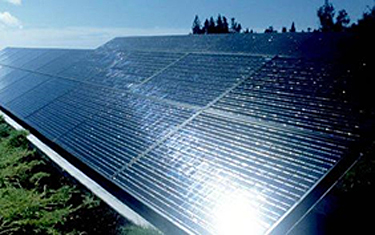
A photovoltaic array
Once efficiency measures have been incorporated, the remaining energy needs can be met using renewable energy technologies. Common on-site electricity generation strategies include photovoltaics (PV), solar water heating, and wind turbines.
Renewable, on-site thermal energy can sometimes be provided by effective use of biomass. Wood, wood pellets, agricultural waste, and similar products can be burned on-site to provide space heating, service water heating, etc. Biofuels, such as biodiesel, may also be used in conjunction with conventional fossil fuels to meet thermal loads. More background on biomass is available in the Alternative Energy page.
Priority should be given to renewable approaches that are readily-available, replicable, and most cost-effective. System maintenance must also be given consideration to over time. Life-cycle cost analysis should be used to evaluate the economic merits of various systems over their usable lifetimes.
Off-Site Renewable Energy
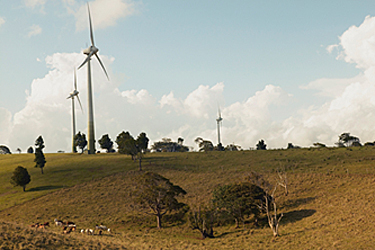
Wind turbines
Depending on the NZE metric and guidelines used, buildings may be permitted to use energy generated off-site to offset energy used in a building. If space is limited, a facility owner may install dedicated wind turbines, solar collectors, etc. at a separate location. Most often, however, credit for off-site renewable generation is gained by purchasing renewable energy credits (RECs).
RECs are available from many renewable energy technologies. Large, utility-scale wind farms, solar plants, geothermal plants, and hydropower facilities generate electricity without using fossil fuels or primary energy. The costs of constructing and operating these generation facilities are often paid for by selling the "credit" for generating energy renewably (as well as selling the energy itself). The structure and market for RECs is evolving and it varies regionally.
Federal Net Zero Energy Building Goals
Two milestones for NZEB have also been defined by the Department of Energy (DOE) for residential and commercial buildings. The priority is to create systems integration solutions that will enable:
- Marketable Net Zero Energy Homes by the year 2020
- Commercial Net Zero Energy Buildings at low incremental cost by the year 2025.
These objectives align with the Energy Independence and Security Act of 2007, which calls for a 100% reduction in fossil-fuel energy use (relative to 2003 levels) for new Federal buildings and major renovations by 2030.
The Building Technologies Office (BTO), created under DOE's Office of Energy Efficiency and Renewable Energy, focuses on improving the efficiency of buildings and their associated equipment, components, and systems. The BTO supports research and development activities, tools, guidelines, training, and technical resources to improve new and existing building performance in both the Commercial and Residential sectors. A Multi-Year Program Plan for the BTO outlines the projected activities and near-term goals of the BTO, including both commercial and residential building research focused on achieving long-term Net Zero goals.
The Net Zero Energy Commercial Building Initiative (CBI) aims to achieve marketable net zero energy buildings by 2025 through an array of public and private partnerships to advance the development and adoption of high-performance buildings.
Parallel residential initiatives are conducted under the Building America Program, which has demonstrated market transformation through research conducted under the BTP. (See the Additional Resources section for links to reports, codes, design guides, software tools, and other key resources to achieve energy reduction and net zero energy strategies available through DOE.)
Application
Net Zero Energy Building principles can be applied to most types of projects, including residential, industrial, and commercial buildings in both new construction and existing buildings. A growing number of projects have been designed and constructed across the various market sectors and climate zones. Several links to DOE's Commercial project resources are provided below, including:
- Commercial Buildings Integration Program
- Commercial Buildings Partnerships
- Better Buidings Alliances
- High-Performance Buildings Database
- Zero Energy Buildings
Commercial Examples
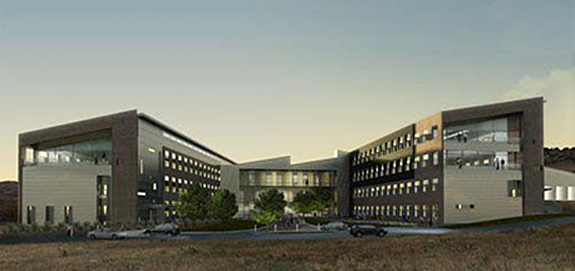
NREL Research Support Facilities Building
In June 2010, the National Renewable Energy Laboratory (NREL) completed the construction of Phase 1 of their Research and Support Facility (RSF). Located in Golden, Colorado, the RSF is currently the largest NZEB in the U.S. The 220,000 sq. ft. project achieved the Net Zero site energy goal through a performance-based design/build process. Numerous energy efficiency strategies were implemented including incorporating advanced heat recovery technologies that were developed and designed by researchers at the Lab and installing 1.6 megawatts of photovoltaic power on the campus through a Power Purchase Agreement. Additionally, daylighting, natural ventilation, and a next-generation, energy efficient data center are among the other energy features of the building.
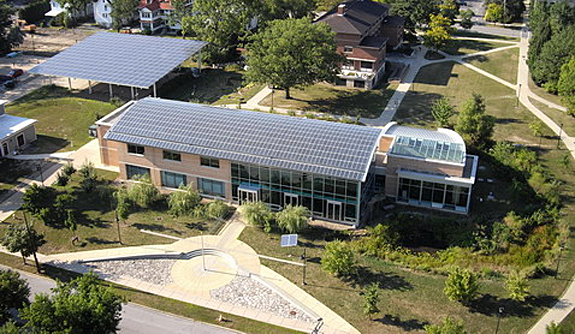
Oberlin College Lewis Center, Oberlin, Ohio
Photo credit: John Petersen, Oberlin College
The Adam Joseph Lewis Center for Environmental Studies, located on the Oberlin College campus in Oberlin, Ohio, is another example of a Net Zero Energy site energy building. The Center was explicitly conceived as an integrated building-landscape system that would continue to change and to improve in performance over time. It houses classroom and office space, an auditorium, a small environmental studies library and resource center, a wastewater-purification system in a greenhouse, and an open atrium. The Lewis Center is an all-electric building and was designed with maximum energy efficiency in mind. The Center generates its own on-site electricity through a roof mounted 60 kW PV system and a 100 kW PV system located over the parking lot. The Center is "grid-interconnected", meaning that when the solar panels produce more electricity than the Center consumes, electricity is exported to the City of Oberlin. Since the parking lot PV array was added in May of 2006, the Center has been a net exporter of electricity - producing more electricity on an annual basis than it consumes. Solar electricity production is coupled with energy efficient lighting, heating, and appliances to minimize negative environmental impact.
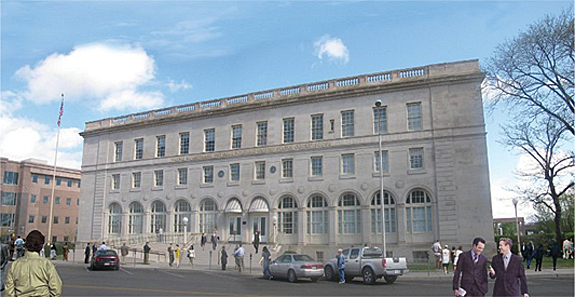
The Wayne N. Aspinall Federal Building and U.S. Courthouse in Grand Junction, CO, which GSA is aiming to turn into a Net-Zero Energy usage historic building.
Photo Credit: GSA
In February 2011, GSA announced its plan to renovate the 92 year-old Wayne Aspinall Federal Building and U.S. Courthouse and make it the country's first Net Zero site energy historic building. The GSA will partner with local Grand Junction, Colorado businesses to maintain the historic features of the building while investing in sustainable technologies that will make it one of the most energy efficient buildings in the country. GSA will install a geothermal heating and cooling system and a solar panel array that will generate enough energy to cover the electricity demand of the building. Any excess energy produced will be exported to the local energy grid. In addition, the building will feature lighting fixtures that adjust in response to natural lighting levels and storm windows with a solar film covering that will reduce the demand on heating and cooling. GSA plans to complete the project by January 2013.
Residential Examples
Refer to Building America for additional case studies of residential projects.
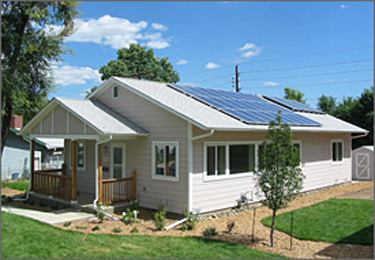
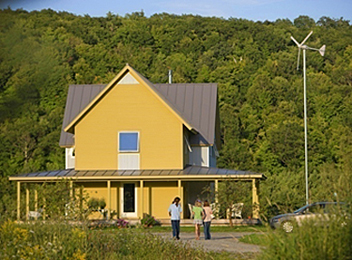
Completed NREL/Habitat Zero Energy Home
Photo Credit: Pete Beverly
The Charlotte Vermont House was able to achieve Net Zero Energy use by using the natural resources of the site—the sun, the earth, and the wind.
The design of this Net Zero source energy Habitat for Humanity home carefully combines envelope efficiency, efficient equipment, appliances and lighting, and passive and active solar features, including photovoltaics (PV), to reach the zero energy goal. The home uses the utility power grid for storage—delivering energy to the grid when the PV system produces more energy than the home uses and draws from the grid when the PV system produces less energy than the house needs. This approach eliminates the need for battery storage and reduces the cost, complexity, and maintenance of the solar electric system. Regular discussions with Habitat construction staff and volunteers weighed the applicability of the optimized solutions to the special needs and economics of a Habitat house which moved the design toward simple, easily maintained mechanical systems, and volunteer-friendly construction techniques. A data acquisition system was installed in the completed home to monitor its performance.
This single family residence in Charlotte, Vermont was designed to maintain all the amenities of a conventional home with as little environmental impact as possible; to eliminate all fossil fuel burning on site; to maintain a high level of design and detail; and to use the most conventional means and methods possible so that it would be affordable and replicable. The challenge was to do all of this in a cold northern climate. The only way to achieve Net Zero site and emissions energy use was to create a house which had an ultra low energy budget utilizing all the natural renewable energy sources the site had to offer.
Relevant Codes and Standards
- ANSI/ASHRAE/IESNA Standard 90.1, Energy Standard for Buildings Except Low-Rise Residential Buildings
- ANSI/ASHRAE/IESNA Standard 100, Energy Efficiency in Existing Buildings
- ANSI/ASHRAE Standard 105, Standard Methods of Determining, Expressing, and Comparing Building Energy Performance and Greenhouse Gas Emissions
- ANSI/ASHRAE/IESNA Standard 189.1, Standard for the Design of High-Performance Green Buildings Except Low-Rise Residential Buildings
- "ASHRAE Vision 2020, Producing Net Zero Energy Buildings," ASHRAE 2008.
- Energy Independence and Security Act of 2007 (EISA)
- Executive Order 13693, "Planning for Federal Sustainability in the Next Decade"
- International Energy Conservation Code (IECC)
- Title 24—2008 California's Energy Efficiency Standards for Residential and Non-Residential Buildings
Additional Resources
Organizations/Associations
Publications
- "Getting to net zero" by Drury Crawley, Shanti Pless, Paul Torcellini. ASHRAE Journal 51(9): 18–25. ASHRAE, September 2009.
- Integration at Its Finest: Success in High-Performance Building Design and Project Delivery in the Federal Sector by Renée Cheng, AIA, Professor, School of Architecture, University of Minnesota. Sponsored by the Office of Federal High-Performance Green Buildings, U.S. General Services Administration, 2014.
- Toward A Zero Energy Home: A complete guide to energy self-sufficiency at home by David Johnston & Scott Gibson. Newtown, CT: Taunton Press, 2010.
Others
- Database of State Incentives for Renewable Energy (DSIRE)
- Department of Energy
- Better Buildings Alliance
- EERE Building Energy Codes Program
- EERE Building Energy Data Book
- EERE Building Technologies Office
- EERE Commercial Building Design and Decision Support Guides
- EERE Commercial Buildings Integration
- EERE Commercial Buildings Partnerships
- EERE High Performance Buildings Database
- EERE High-Performance Green Building Partnership Consortia
- EERE Residential Building America Program
- EERE WINDExchange Wind Resource Map
- EERE Zero Energy Buildings
- NREL Report "Definition of a 'Zero Net Energy' Community" November 2009
- NREL Report "Getting to Net Zero" September 2009
- NREL Report "Zero Energy Buildings: A Classification System Based on Renewable Energy Supply Options" June 2010
- NREL Report "Zero Energy Buildings: A Critical Look at the Definition" June 2006
- GSA Sustainable Facilities Tool (SFTool)—SFTool's immersive virtual environment addresses all your sustainability planning, designing and procurement needs.
- IBPSA-USA BEST (Building Energy Software Tools) Directory
- New Buildings Institute Getting to Zero Buildings Database
- U.S. Army NZE Pilot Installations Information
- U.S. Energy Information Administration - Commercial Building Energy Consumption Survey








